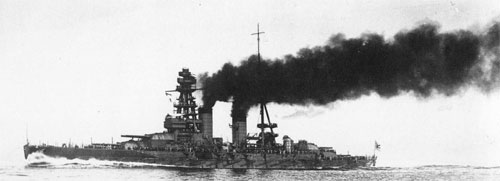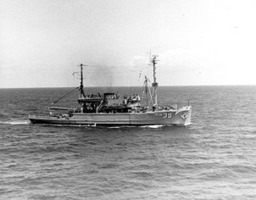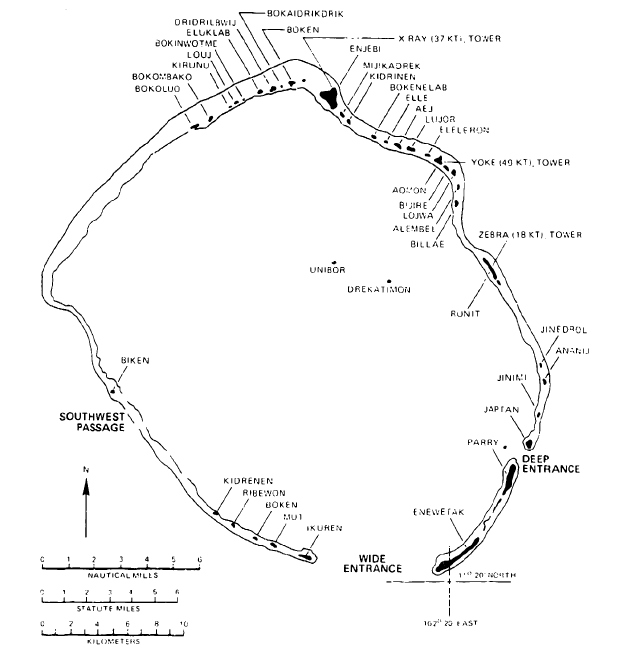
Late in the afternoon of March 30th a speck was seen on the horizon. A tug had found us! It took Sakawa in tow, and then slowly vanished over the blue disk of the horizon. Another tug appeared before midnight. I was glad the Captain told her to lie off until morning. When the sun was an hour high, we tried first to fuel from her.
All hands were ready with spars weighted at the butt with pieces of iron, and each with a light line lashed to the smaller end. As the tug closed amidships, we thrust them in between; they saved her from destruction for our massive side. A hose was passed without difficulty and we began to take oil. But the spar only lasted a few minutes; almost every roll of the tug splintered one. It became like a production operation: men on the hanger-deck brought new spars out and cut notches in them with axes, other men fastened lines and weights, men on the blister thrust them in between, while still other men retrieved lines from splintered stumps. Meanwhile, we finally realized it was only a question of time before a larger swell crushed her against us in spite of the spars. After we had a few thousand gallons, she knocked off fueling and prepared to take us in tow.
Before that could be done, we had to get the sea anchor in. It was a Herculean task – the temptation to slip the sea anchor great, but we might need it again. The last impediment came off late that afternoon. Then, with no steam to work the winch, we had to call all hands to get the tug’s wires aboard. Before sunset she had taken the strain and we seemed to be making three knots due south towards our destination in the Marshall Islands. The crew turned in for what was supposed to be a night’s sleep.

(USS Clamp, ARS-33. Photo USN).
Towards midnight a larger tug- USS CLAMP (ARS-33)- showed up. Her skipper didn’t want to tow in tandem so we had to call all hands to take the strain off the small tug’s wire while we unshackled. She went astern of us to await further orders. We sat on the forecastle, waiting under the stars. The ship’s battery had revived enough to supply the feeble floodlights, but they were turned out. Only the barely audible sobbing of the wind was to be heard. The red riding light of the larger tug was just visible off to starboard. Slowly, it brightened until we picked up the muffled singsong of her engines. Then she seemed to burst upon us out of the night, her floodlit fantail alive with barebacked, sweating men, blazing away with line throwing guns.
Our men ducked warily behind bits and winches, for the line-throwing slug weighs half a pound and can deal with a vicious blow. The light threads they carried over were lost in the darkness; we could not find them. The tug passed under our bow, circled, and came in again, still firing. One of our crew caught a thread well aft. Fifty men were upon it like demons. The duck thudded as they pressed forward in a whirling mob, keeping pace with the tug. A heavier line came singing over as they reached our bow; they whisked it through the check, raced aft; in less than ten seconds a three-inch line was aboard. Others milling on the bow seized on that, made off with it, streaking aft. An eight-inch hawser came aboard.
Men came racing from everywhere to heave in on it. The tug was back down under our bow; I saw the end of her bow go overboard. All hands were straining on the eight-inch in the yellow glow of the floodlights; it eased in steadily until the eye of the wire came in through the check to the Bo’sun waiting with his heavy steel pin to shackle on. No one had to give an order; it was teamwork, concentrated energy, the will to win. It confirmed what I had realized for several days – we now had a real professional deck force.
Climbing up to relieve the watch, I reviewed the steps by which this had come about. The original members of the deck forces were not much better than they had been; a little smarter, a little more muscular, perhaps, but still drudges. This new strength of the team came from men not normally rated to be deck people at all. The case of a signalman flashed through my mind as a series of vivid pictures. I noticed him first as we were preparing to tow, watching intently from the signal bridge. By the time we had worked up forward, he was down to the hurricane deck, still watching. As we passed lines between the ships, he mingled with the deck force, diffident and uncertain, but heaving round every time he got the chance. During the dangerous operation of freeing the wire, I saw him hanging over the edge of the wave-swept blister, easing it over an obstruction while two other men held him by the foot. From there on, he was always in the thick of things. A middle-aged Chief, constrained to paper-pushing administrative work those many years, plunged in like an eighteen-year-old. One of the ship-fitters took his place right behind the Bo’sun and stayed there.
So it was: cooks, an alleged steward, radio men, messmen, a storekeeper, learned as I watched down from the pagoda, until I could call “all hands on deck!” and relax, completely confident. It was the American spirit, plus the leader on the deck, the Bo’sun. It was an unbeatable combination.
Next morning we fueled again from the smaller tug, but not alongside this time. The plan was for her to steam close in on our starboard quarter where we would pass her a hose lashed to a three-inch line.
The first try almost cancelled the idea. The tug got in position all right, then came careening down the slope of a great swell, putting her anchor through a splinter shield with a ringing crash. The steel was twisted and torn with the clean forty-five degree fracture one normally associates with the detonation of high explosives. Then she went lurching up our side, carrying away booms, davits, stanchions, safety lines and all her own beading, and taking several gashes in her wooden hull, none of them clear though.
She got clear in no danger of sinking, and regained position. We passed the hose. It worked this time, and black oil was soon bubbling into our tanks. Once or twice the hose burst, spraying us with DFM, but new sections were quickly substituted for the torn ones.
The trouble was the great labor of handling the hose. It was a big job. The tug could not keep station accurately, ranging ahead and behind, in and out. Our men had to pay out hose as she bore away, take it in smartly as she came back, keeping it out of the water where the waves might tear it loose. Thirty men were barely enough to do it, and they lasted only a little while before they were exhausted and had to be relieved. We kept that up all day, changing the watch once an hour. We had our reward; by nightfall, steam had been raised and lights and pumps were going again.
Next morning, land was sighted from the fore top, only to be lost to view as the wind freshened and the tug could no longer hold our head to the seas.
By noon we were back; by late afternoon we could make out ships in the anchorage. Then we received an extraordinary message. Just after sunset, I went out on the forecastle and told the leading petty officer to take all the men he could find and close ports, hatches, and watertight doors, working back inside the armor, taking all the men with him. He looked at me with question marks in his eyes. I told him I really was crazy just as he had always thought, but to go ahead and do it anyway.
He did.
Later I learned his theory was that I knew the collision with a reef was inevitable. Actually, the message was from the Fleet Commander’s weather guesser, and it informed us that a tidal wave might be coming our way, and to take precautions. The tug had reversed course and was trying to get us to deep water where we would have a better chance, though she might not. It was too hot to keep the men inside the armor citadel very long; we let them come out on one of the upper decks aft of the pagoda, hoping to see the wave in time to get them undercover. I wanted the Captain to run up the Dutch Ensign as a signal to drop the anchor, but he wouldn’t.
Nothing happened through the night. The next morning, we found ourselves 30 miles out to sea facing another day of tugboats, broken tow lines, power failures and a bunch of upset sailors. Though we never felt the effect of the tidal wave where thousands of Hawaiians were made homeless, we did manage to drop the anchor in Enewetak on April 4th, the 18th day of the voyage, sporting a drunken seven-degree list to port.
Now in safe anchorage, we could start pumping Nagato out, fix her boilers, and prepare for the last 200 miles to Bikini.
And our date with The Atom Bomb

Copyright 2015 Vic Socota
www.vicsocotra.com
Twitter: @jayare303
